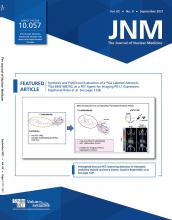TO THE EDITOR: With great interest, we recently read Strosberg et al.’s publication regarding the risk of bowel obstruction in patients with mesenteric or peritoneal disease who receive peptide receptor radionuclide therapy (PRRT) (1). At the author’s institution, 5 patients experienced a bowel obstruction within 3 mo of treatment. The authors hypothesized that the mechanism of the bowel obstruction was inflammation induced by PRRT; this hypothesis was supported by surgical findings of a “frozen abdomen” in 2 of those patients. Before their publication, there had been no known reports highlighting intestinal obstruction as a complication of PRRT.
On the basis of our institution’s experience with PRRT (177Lu-DOTATATE) for gastroenteropancreatic neuroendocrine tumors, we would like to provide further evidence supporting Strosberg et al.’s hypothesis by reporting additional cases of bowel obstruction after PRRT. After witnessing several patients presenting with abdominal pain in the days shortly after treatment, we reviewed 80 patients who received PRRT before December 2018 at our institution. We found that 16 patients went to the emergency department or were admitted to the hospital within the first 14 d after a PRRT cycle, 4 of whom were ultimately diagnosed with a bowel obstruction.
Our findings are in contrast to the clinical trial data from NETTER-1. In the supplemental appendix of an article on that trial, there was a report of only 2 hospitalizations among a much larger cohort of patients who received PRRT (n = 116) (2). This finding could be explained by significant differences between the study population and our real-world cohorts. In the NETTER-1 trial, only 17 (15%) and 7 (6%) of the patients in the PRRT arm had metastases to the mesentery and peritoneum, respectively. On the other hand, all 4 of our patients who had a bowel obstruction had known peritoneal disease, and in Strosberg et al.’s report, 81 of 159 (51%) of their patients had peritoneal or mesenteric disease, including all 5 who had an obstruction (1).
Although peritoneal disease itself is a risk factor for intestinal obstruction, the fact that the patients at our institution developed obstructive complications within 14 d of PRRT treatment suggests an even stronger temporal cause–effect relationship. The hypothesized inflammation mechanism is even further supported by the radiographic finding of pseudoprogression with neuroendocrine tumors, which has already been commonly observed, as shown by other reports (3).
Existing literature regarding the safety of PRRT has previously focused primarily on long-term complications and laboratory abnormalities, such as hematologic or renal toxicity. For example, the rare but serious complication of secondary myeloid neoplasms has been well documented (4). There are fewer reports of immediate toxicity or short-term complications, but in 1 retrospective review of patients who received PRRT for grade 3 neuroendocrine tumors (n = 69), the authors reported that “PRRT was well tolerated by all patients” (5).
Unfortunately, our real-world experience provides additional examples that support Strosberg et al.’s observation that bowel obstruction is a short-term complication of PRRT treatment in patients with baseline peritoneal and mesenteric disease. To our knowledge, ours is the only other report that highlights this specific complication of PRRT. Clinicians should remain cognizant of the potential for intestinal obstruction when weighing risks and benefits of treatment options until we have more definitive evidence and experience.
Footnotes
Published online March 19, 2021.
- © 2021 by the Society of Nuclear Medicine and Molecular Imaging.







